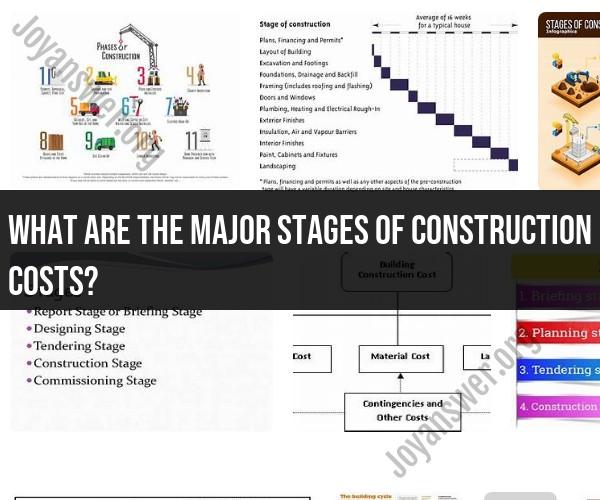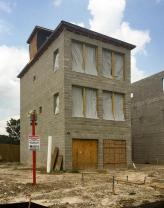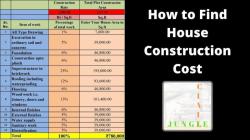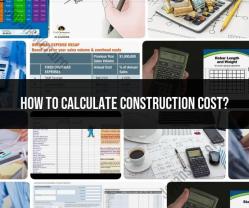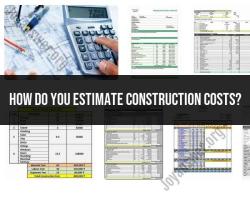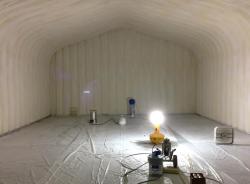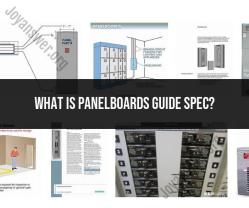What are the major stages of construction costs?
The construction process involves various stages, and each stage has associated costs. The major stages of construction costs typically include the following:
Pre-Construction Costs:
- Feasibility Studies: Initial studies to determine the viability of the project.
- Design and Architectural Planning: Costs related to architectural and engineering services.
- Permits and Approvals: Expenses for obtaining permits and regulatory approvals.
- Land Acquisition: Costs associated with purchasing or leasing land.
Site Preparation Costs:
- Demolition and Site Clearing: Expenses for clearing the construction site and demolishing existing structures, if necessary.
- Grading and Excavation: Costs for leveling the site and excavating for foundations.
Foundation and Substructure Costs:
- Foundation Construction: Expenses for constructing the building's foundation, such as footings, piers, and slabs.
- Substructure: Costs for building the basement or lower levels.
Superstructure Costs:
- Framing and Structural Components: Expenses for constructing the building's framework, including walls, columns, and beams.
- Roofing and Enclosure: Costs related to roofing, exterior walls, doors, and windows.
Exterior Finishes:
- Exterior Cladding: Expenses for materials and labor related to exterior finishes, such as siding or masonry.
- Roofing Materials: Costs for roofing materials and installation.
Interior Finishes:
- Interior Walls and Partitions: Expenses for framing and finishing interior walls.
- Flooring: Costs associated with flooring materials and installation.
- Ceilings: Expenses for ceiling construction and finishes.
- Paint and Wall Coverings: Costs for paint, wallpaper, or other wall coverings.
- Cabinetry and Fixtures: Expenses for kitchen and bathroom cabinets and fixtures.
- Interior Doors and Hardware: Costs for interior doors and hardware.
- Electrical and Lighting: Expenses for electrical wiring, outlets, and lighting fixtures.
- Plumbing: Costs related to plumbing systems and fixtures.
Mechanical and Electrical Systems:
- HVAC (Heating, Ventilation, and Air Conditioning): Costs for HVAC systems and installation.
- Electrical Systems: Expenses for electrical systems, including wiring and distribution.
- Plumbing Systems: Costs related to plumbing systems, piping, and fixtures.
Landscaping and Exterior Features:
- Landscaping: Expenses for landscaping, irrigation, and outdoor features.
- Site Amenities: Costs for outdoor amenities like sidewalks, parking lots, and signage.
General Conditions:
- Temporary Facilities: Expenses for on-site offices, storage, and temporary utilities.
- Site Security: Costs for security measures during construction.
- Safety and Quality Control: Expenses related to safety measures and quality control.
- Contingency: A reserve fund for unexpected costs or changes in the project.
Management and General Costs:
- Project Management: Costs associated with project management and oversight.
- General Conditions: General overhead expenses, insurance, and permits.
Financing Costs:
- Interest and Financing Fees: Costs related to project financing, including loan interest and fees.
- Bond Costs: Expenses for project bonds or other financial instruments.
Escalation and Inflation:
- Costs associated with price escalation or inflation over the course of the project.
It's important to note that these stages and their associated costs can vary depending on the complexity and scale of the construction project, as well as regional factors, market conditions, and specific project requirements. Construction costs can also be categorized as either direct costs (related to the physical construction) or indirect costs (overhead, administration, financing, etc.). Accurate cost estimation and management are crucial for a successful construction project.
Construction Cost Stages: Understanding the Phases
The construction cost stages are the different phases of a construction project, each of which has its own associated costs. The stages are typically as follows:
- Pre-construction: This stage includes planning, design, and permitting. Costs at this stage include design fees, engineering fees, and permit fees.
- Mobilization: This stage includes setting up the construction site and bringing in materials and equipment. Costs at this stage include site preparation costs, equipment rental costs, and material costs.
- Construction: This stage is the actual building of the structure. Costs at this stage include labor costs, material costs, and equipment rental costs.
- Demobilization: This stage includes cleaning up the construction site and removing materials and equipment. Costs at this stage include waste disposal costs and equipment rental costs.
- Post-construction: This stage includes final inspections and warranties. Costs at this stage include inspection fees and warranty costs.
Breaking Down Construction Costs: Key Stages and Considerations
The following are some of the key considerations for each construction cost stage:
- Pre-construction: It is important to have a well-defined scope of work and budget in place before starting construction. This will help to minimize the risk of cost overruns.
- Mobilization: Mobilization costs can vary depending on the size and complexity of the project. It is important to get quotes from multiple contractors and to factor in the cost of transportation and insurance.
- Construction: Labor costs are typically the largest component of construction costs. It is important to get quotes from multiple contractors and to factor in the cost of overtime and specialized labor.
- Demobilization: Demobilization costs can be minimized by planning ahead and by working with contractors who have experience with this type of work.
- Post-construction: Post-construction costs are typically relatively low, but they should still be included in the budget.
Cost Management in Construction: Major Stages and Strategies
There are a number of strategies that can be used to manage costs throughout the construction process. Some of the most common strategies include:
- Value engineering: Value engineering is a process of analyzing the project's design and construction methods to identify ways to reduce costs without sacrificing quality or performance.
- Change management: Change management is a process of managing changes to the project's scope, schedule, and budget. This process can help to minimize the impact of changes on costs.
- Risk management: Risk management is a process of identifying, assessing, and mitigating risks to the project. This process can help to prevent cost overruns caused by unexpected events.
- Scheduling: Effective scheduling can help to minimize costs by ensuring that resources are used efficiently and that the project stays on track.
- Cost tracking: Cost tracking is essential for identifying and addressing potential cost overruns early on. This can be done by comparing actual costs to budgeted costs and by reviewing expense reports regularly.
By following these strategies, construction companies can manage costs effectively and deliver projects on time and within budget.
